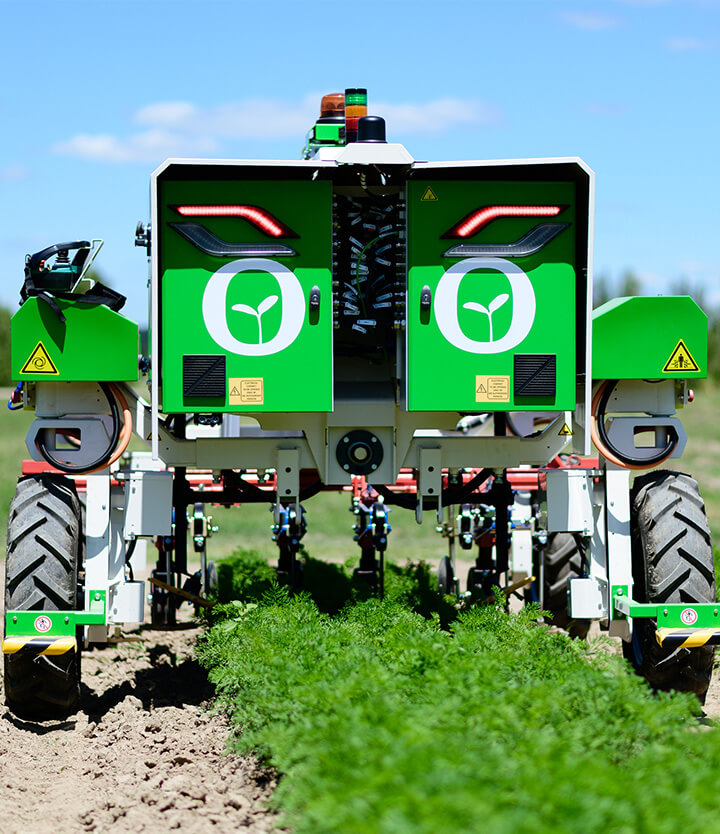Digital technologies are now part of everyday life for farmers: small and large agricultural businesses, young and not-so-young farmers, almost everyone is using them. The sector is therefore producing a wealth of data, which can be used to improve economic and environmental performance and guide decision-making. However, the digital transition is only just beginning, and questions are still being raised.
Transforming data into decision-making tools
GPS, drones, robots equipped with sensors, mobile applications and connected devices are all tools that facilitate the
everyday lives of farmers, helping them optimise the running of their businesses and make informed decisions. Monitoring fields, herds and buildings, examining
weather and market developments and forecasting yields, agriculture as a whole generates a vast amount of valuable data.
With the availability of this “agricultural data”, the stakes are high across the entire sector. “There is much to do on traceability, with high societal expectations for greater transparency on food products. The data collected can also be used to increase the competitiveness and productivity of farms, making it possible to enhance both their economic and environmental performance” states Guillaume Joyau,Head of Research & Innovation at the Department for Economy and Sustainable Development of the FNSEA (Fédération Nationale des Syndicats d’Exploitants Agricoles – French Federation of Farmers’ Unions). He also notes the impact of using digital technology and data analysis on the everyday lives of farmers, reducing on-call time and informing them of incidents quickly, and often remotely.
“The value for farmers is very real. Being able, for example, to observe the health of crops, via sensors passing very close to the plants, means they can plan targeted actions in case of disease”, concludes Jean Inderchit, Product Manager at Naïo Technologies.
Step-by-step digitisation
Although the use of data is already relatively widespread on vineyards, farm digitisation is, generally, still in its infancy, and barriers remain. Firstly, the investment costs, equipment renewal cycles being staggered over one, or sometimes even two, decades. Also, the necessary infrastructure deployment for good network coverage, some areas still being largely incompatible with constant connectivity. And there are still no standards for the tools and protocols used, making communication and interoperability between different data collection systems complex.
And then, using the data collected in the fields raises yet more questions. “Although it is the farmers who are actually producing this data, through their work, the analyse, aggregation and cross-referencing with other data and then transformation into usable information very often falls to third-party specialists”, explains Guillaume Joyau. This raises questions about how the data is used, its portability and even its storage… The DATA-AGRI charter and label, created by the Conseil de l’Agriculture Française (French Agriculture Council) (of which the FNSEA
is a member), aim to establish a code of ethics and fair practices for agricultural digital technology. “Ensuring transparency and guaranteeing that farmers have control of how their data is used, creates favourable conditions for data use right along the chain. These are the key issues in building the emerging ecosystem” sums up Guillaume Joyau.
Emergence of “Smart Agriculture”
What is more, the analysis and interpretation of “Agricultural Big Data” today represents an opportunity to profoundly revolutionise agricultural practices.
“The data collection must have a very precise and useful aim to offer genuine assistance in the running of a farm. If an autonomous robot can, at the same time as weeding lettuce plots, count the plants and determine their location, providing farmers with maps of their fields, the number of heads and the average diameter, this provides farmers with an extremely high level of information to optimise the manner in which they grow their plants”, illustrates Jean Inderchit of Naïo. Yield forecasts, practice improvements and even early detection of disease, making it possible to act locally to prevent the spraying of products that are harmful to the environment and the user, are all areas in which the data can be highly effective, opening the way to precision agriculture.
For Guillaume Joyau, it is clear that “digital technology is a means of responding to many of the new issues with which we are faced. Climate change, for example, brings different diseases, different monitoring and new emerging risks, which digital tools can help us manage. And in the same way that mechanisation transformed agriculture in the 60s, these technologies will certainly lead us to change the way we approach production and the agricultural landscape, by designing new models”.





